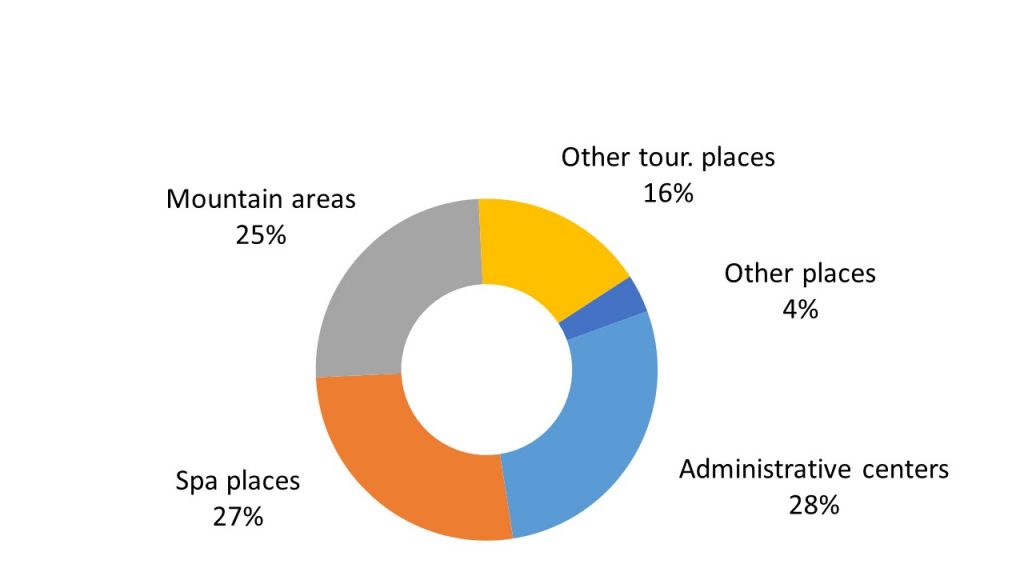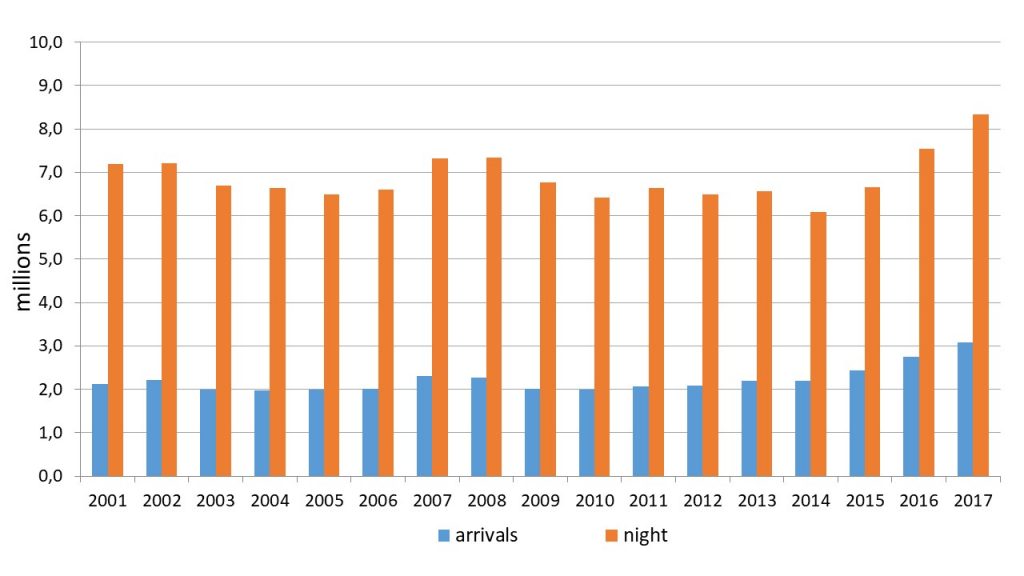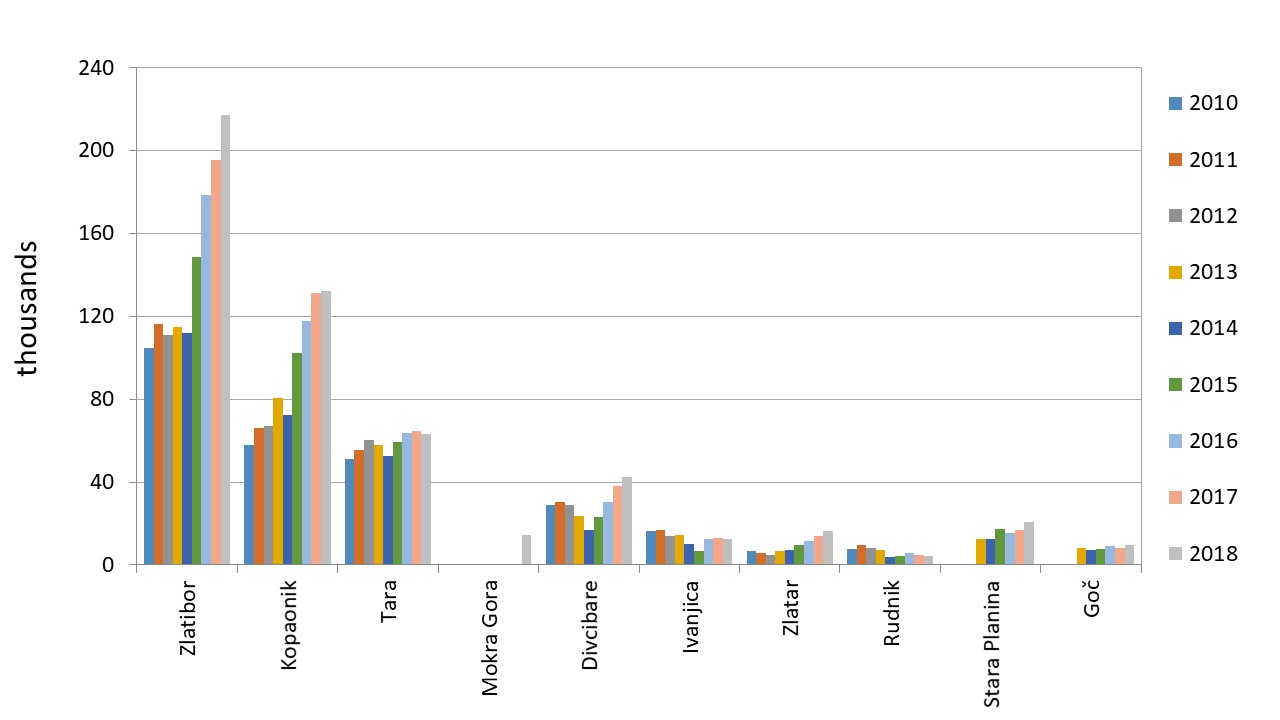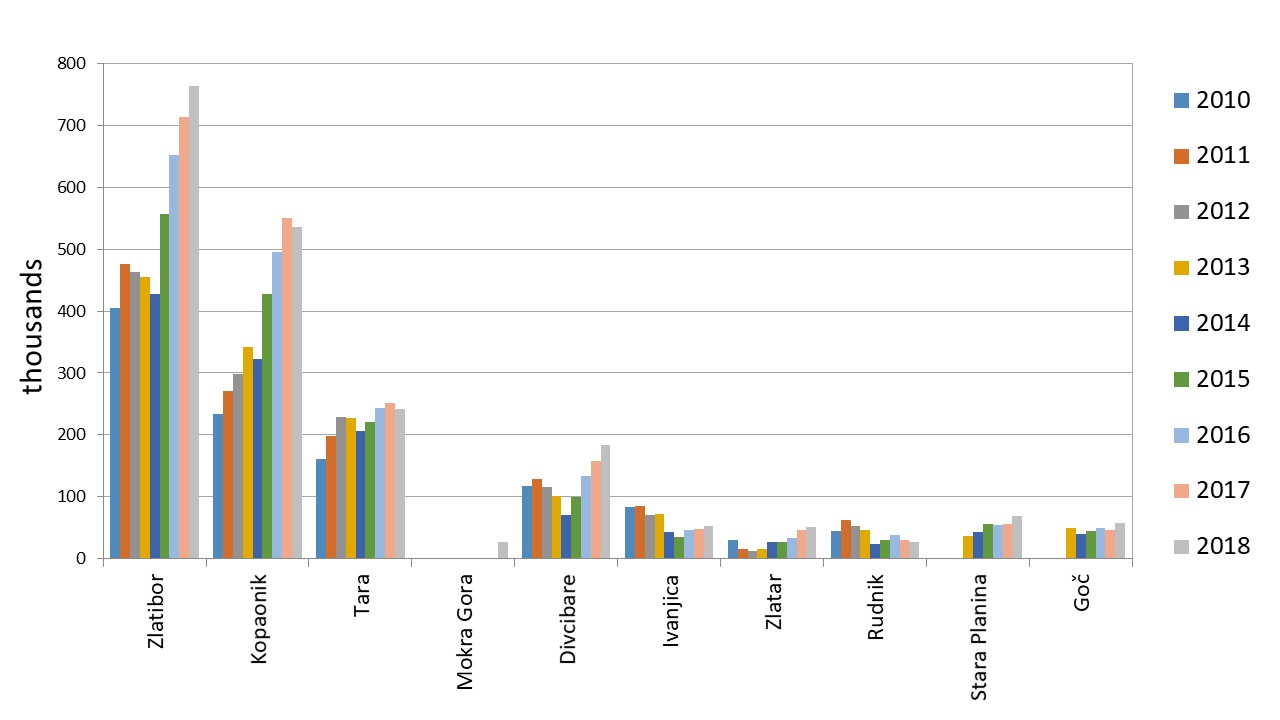Key message: Number of tourists in mountain areas increase
Assessment: This indicator is developed within the Serbian Environmental Protection Agency environmental information system. The indicator shows the trend of arrivals and overnight stays, the temporal and spatial distribution of tourists by tourist resorts, in order to monitor the pressures on the environment and biodiversity. The term “arrivals” means the number of tourists staying one or more nights in the accommodation facility in the observed period and the term “night” means number of overnight stays by tourists realised in the accommodation facility. There are no statistics for all protected areas in the mountains. Also, the surface of protected areas do not correspond completely to the surface of tourist area in mountains, so it is not possible to calculate a ‘total tourist density’ (the number of arrivals and overnight stays in the protected area). The most interesting sites for the tourists were Zlatibor, Kopaonik, Tara and Divčibare mountains. Les interesting were Goč, Stara Planina and Mokra Gora mountains. In the period 2010-2018, the number of visits and tourist nights doubled on Zlatibor and Kopaonik mountains.
Protection of environment is an important segment for the sustainable development of tourism, so special attention is given to maintaining the quality of the environment. Special attractions are protected natural areas with great importance for development of tourism. Bearing in mind that negative impacts of tourism on the environment reflects primarily on natural resources and biodiversity, sustainable management of protected areas is an essential prerequisite for sustainable tourism development. In this context, the Tourism Development Strategy of the Republic of Serbia until 2025 (“Official Gazette of RS” No. 98/2016) highlights sustainable ecological development as one of the main objectives and introduces mechanism of monitoring of touristic activities in protected areas taking into account all potentially positive and negative effects thereof.




Indicator Name: The intensity of tourism in the mountains
Institution/Author: Environmental Protection Agency/Maja Krunić-Lazić, Slaviša Popović
Use and interpretation:
Serbian Environmental Protection Agency (SEPA) in its Annual Reports on Economic Potentials and Activities of Importance for the Environment and Annual Reports on State of the Environment of the Republic of Serbia. The indicator relates to the total area of Republic of Serbia.
The indicator shows the arrivals and overnight stays, the temporal and spatial distribution by types of tourist resorts, in order to monitor the pressures on the environment. The term arrivals means the number of tourists staying one or more nights in the accommodation facility in the observed period . The night belongs to the number of overnight stays by tourists realised in the accommodation facility.
According to established criteria, all the places are divided into five categories: main administrative centres , spa resorts, mountain resorts, other tourist resorts and other places.
Key question(s) which indicator helps to answer
The indicator helps to answer two questions: Where are the potentially most frequented protected areas? and Are we reducing the spatial pressure from tourism infrastructures?
Use of indicator
To measure reducing the potential impact of tourism in protected areas
Scale of appropriate use
Total area of Republic of Serbia and individual mountains. Therefore, the indicator is compatible with indicators of the same size.
Potential for aggregation:
It is not possible to analyse the level of administrative regions and districts
Meaning of upward or downward trends (“good or bad”)
There is an increase in the number of tourists in the protected areas every year, which potentially has a negative impact on biodiversity
Possible reasons for upward or downward trends:
The indicator is determined annually. It is important for monitoring system of biodiversity protection in Serbia. Practically, increasing the number of tourists in protected areas should have a negative impact on biodiversity
Implications for biodiversity management of change in the indicator:
Indicator “Intensity of Tourism” is traditionally described in the Annual Reports on Economic Potentials and Activities of Importance for the Environment and Annual Reports on State of the Environment of the Republic of Serbia, and is defined as an indicator of economic activity, in accordance with the Regulations on the National list of indicators of environmental protection (Official Gazette of the Republic of Serbia No. 37/2011). However, the indicator “The intensity of tourism in the mountains” was not developed algorithm of converting the indicator of biodiversity. From now on, this will be taken into account for the purpose of implementation of the Biodiversity Strategy.
Units in which it is expressed:
− Tourist arrivals and nights in thousands of tourists.
− Tourist traffic and stays by types of tourist sites: in thousands of tourists and the percentage of participation in relation to the total turnover.
Description of source data:
The Statistical Office of the Republic of Serbia and the Touristic Registry
Periodicity of collecting: per year
Calculation procedure:
The Statistical Office of the Republic of Serbia collects data monthly report of restaurants and other businesses that provide accommodation services to tourists, or to mediate in the provision of these services.
The data are taken from the Serbian Statistics, and recalculated for the purpose of this indicator.
Limits to usefulness and accuracy:
Archives and annual statistics for arrivals and overnight stays in the mountains, cannot be accessed on the official website of the SORS, more information is available at the official request.
Updating the indicator:
Statistical data are updated once a year.
Closely related indicators
/
Additional information and comments
The Environmental Protection Agency collects data through the Environmental Information System, as well as in direct cooperation with relevant institutions for certain thematic areas and prepares annual Reports on Economic instruments for environmental protection in the Republic of Serbia and annual Reports on State of the Environment of the Republic of Serbia, on the basis of articles 76 and 77 of the Law on Environmental Protection (Official Gazette of RS No. 135/2004, 36/2009, 36/2009 – state law, 72/2009 – state law and 43/2011 – CC decision, and 14/2016).
Reports provide an overview of economic instruments in the environmental sector in the Republic of Serbia based on available data, industry, energy, agriculture, tourism and urbanisation. In this way, an insight is obtained on the achievement of goals and measures of environmental policy defined by strategic and planning documents, such as: National Environmental Programme (Official Gazette of RS No. 12/10), National Strategy for Sustainable Use of Natural Resources and Goods (Official Gazette of RS No. 33/12), and National Sustainable Development Strategy (Official Gazette of RS No. 57/08). Efficient system of economic instruments should encourage the reduction of pollution, while introducing adequate financial mechanisms to motivate environmental investments. In order to achieve that, economic mechanisms must be established to signal timely and clearly to polluters and end-users of goods and services that there are economic benefits from environmental investments.
In this context, the Tourism Development Strategy of the Republic of Serbia until 2025 (Official Gazette of RS No. 98/2016), includes, as one of the main objectives, sustainable ecological development and introduces monitoring of protected areas in the field of touristic activities, taking into account all potential positive and negative effects of the development of tourism might have on them.
Analysis
Since the Republic of Serbia is not the destination of “mass tourism”, the tourism turnover is almost unchanged in the period 2001-2017. In 2017, there were a total of 3.09 million tourist arrivals and 8.33 million overnight stays.
Measured by the number of arrivals, tourists were most numerous in the main administrative centres with 1,173,017 arrivals, other tourist and mountain resorts (respectively 705,966 and 556,213). Measured by the number of overnight stays, the biggest turnover had administrative centres (2,337,272 nights), spa and mountain resorts (respectively 2,227,945 and 2,078,690 overnights).
A special attraction is the protected natural areas as a resource of great importance for the development of tourism. As the mountains are largely covered by some kind of nature protection, based on the available data, the intensity of tourism on the mountains is analysed, which includes arrivals and tourist nights.
Measured by the number of arrivals and overnight stays in the period 2010-2018, the most attractive destinations for tourists are Zlatibor (Nature Park) and Kopaonik (National Park), then Tara (National Park) and Divčibare. Tourists visit other mountains, covered by some form of nature protection, to somewhat less extent, that are: Goč (Special Nature Reserve), Stara Planina and Mokra Gora that have Nature Parks therein.
In the observed period, the number of tourist arrivals and overnight stays on Zlatibor and Kopaonik had increased by about 100%, while on other mountains it has been slightly changed, as can be seen on the charts.
The analysis of arrivals and overnight stays by months indicates that Zlatibor has been equally visited throughout the year. Kopaonik, as the largest ski centre in Serbia, has significantly more visitors in the winter, due to the ski season, than during the rest of the year. Tara is most visited in spring and summer.
Serbia